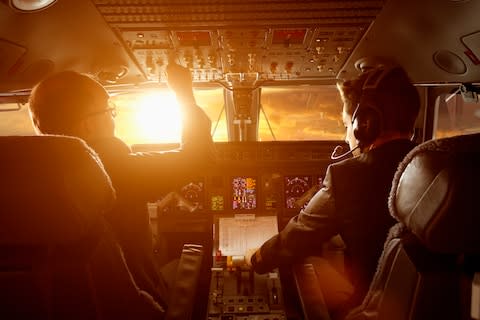Is a smooth landing the test of a good pilot – and should we clap after touchdown?

If you’ve travelled on a plane enough times, you’ve probably experienced a bumpy landing or two. It’s not a particularly reassuring feeling - but is it the reflection of a bad pilot? Telegraph Travel investigates.
The art of a good landing
“There’s no point denying that the autopilot does most of the work,” Sam Bray, a Monarch pilot, previously told Telegraph Travel. “On a regular flight the autopilot does around 90 per cent of the flying.” It's the take-off and landings which require by far the most attention on the pilot’s part.
A good landing does therefore reflect a pilot’s skill, according to Joe D’Eon, a former pilot, who suggests: "If you want to say something nice to a pilot as you’re getting off the plane, say ‘Nice landing.’ We do appreciate that.”
According to Mark Vanhoenacker, senior first officer for British Airways and author of How to Land a Plane, it's also one of the best parts of a flight.
“Landings are by definition a transitional experience,” he writes. “We’re guiding a fast, powerful vessel from one unique realm, the air, onto the ground, which is quite another.”

So how does it work? Once you’ve made all the calculations in relation to your speed (too fast - bad, too slow - bad) and altitude, it’s time for the all-important ‘flare’.
“The landing manouver starts with the flare," Mr Vanhoenacker explains. "Techniques vary, but usually, when you flare, you pull the nose up a little while starting to reduce power. Raising the nose reduces the descent rate, allowing you to lightly descend onto the runway. The flare is a tough manoeuvre and it’s one that pilots continue to refine throughout their careers.”
Is smoother better?
The prospect of a ‘good’ landing being a smooth one, however, is a myth. “A firm touchdown is, if anything, preferable to a softer one if the runway is short, wet or snow-covered, or if it’s very windy,” Mr Vanhoenacker writes. “As it says in the fine print of the mighty 747’s manuals: ‘A smooth touchdown is not the criterion for a safe landing.’”
Patrick Smith, a US pilot and author of Cockpit Confidential, agrees: “Although passengers put a lot of stock in the smoothness of a touchdown, this is hardly an accurate benchmark of skill. A firm or ‘crooked’ landing is often exactly what the pilot is aiming for. On short runways, the priority is getting the plane safely onto the ground within the touchdown zone, not finessing it.”
Pilots actually love a tricky landing
Telegraph Travel quizzed a clutch of pilots about their favourite airports to touch down at last year. Naples, Madeira, Innsbruck and Gibraltar cropped up frequently, and they all have one thing in common: they are among the trickiest in Europe, with pilots often needing special training before they’re allowed to tackle them.

If at first you don’t succeed…
According to Mr Vanhoenacker, rushing an approach before you’re ready to land is “pretty much the worst thing you can do” as a pilot.
“An approach to a runway typically features what’s called a ‘decision altitude’ or a ‘decision height’”, he states. “When pilots reach this decision point, we need to be able to see the runway or its associated lights in order to continue the approach. If not, then you must prepare to ascend again and perform a go-around. This decision point is so important that a computer may announce it out loud in the cockpit.”
It’s more or less what went wrong back in 2007 when Garuda Indonesia Flight 200 overshot the runway and crashed into a rice field, killing 21 people. A report later put the accident down to human error, after the pilot made an “excessively steep and fast, unstabilised approach” - ignoring repeated warnings to instead perform a go-around and try again.

Landing in a crosswind
A crosswind is a strong wind that blows across the direction the aircraft is travelling in, making it more difficult to keep it stable.
Dave Kistruck, Vice President of Aircraft Operations at Virgin Atlantic told us: “A good landing is about being on the runway centreline, in the touchdown zone with the aircraft at the right speed. However, a pilot can get all these things right but the landing can still be affected by weather - crosswinds for example - which may cause a bumpy or a particularly hard landing.”
“When a plane is landing in a crosswind, pilots will commonly aim the plane into the wind, a manoeuvre that will ensure that the aeroplane’s path over the ground takes it directly to the runway. This technique is effective but challenging,” explains Mr Vanhoenacker.
“The correct technique in a crosswind is a slightly skewed alignment, with one set of tyres hitting the ground before the other,” states Mr Smith.
So while to passengers this uneven landing might feel ‘wrong’, it’s actually quite the opposite.

Why do we clap during landings?
“Clapping upon landing was still widespread as recently as the late 70s and early 80s,” according to Mr Smith, adding that for most of us, the novelty has by now worn off.
“You’ll notice that when it does happen, it’s a strictly economy class phenomenon,” he says. Not for socioeconomic reasons, Mr Smith points out, rather that the dynamics of more people sitting closer together generates a certain “communal spirit.”
So does a good clap give the pilot the warm fuzzies? Oh yes, according to Mr Kistruck: “Although rare these days, it’s always appreciated.”


